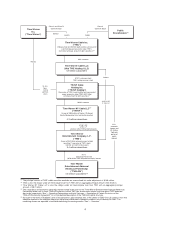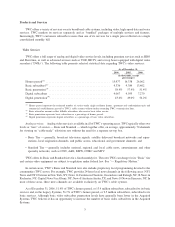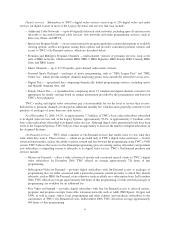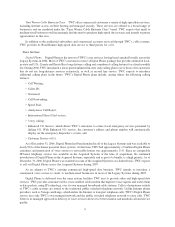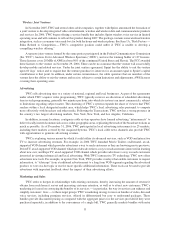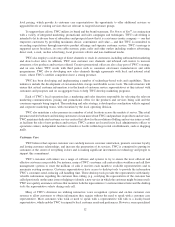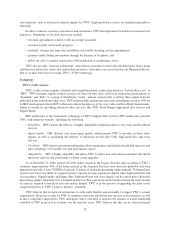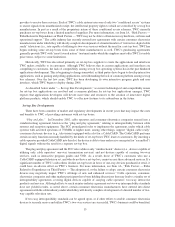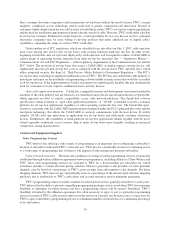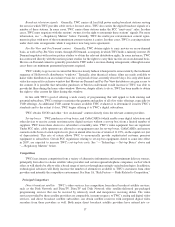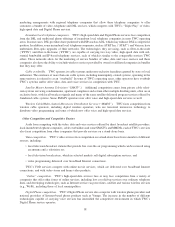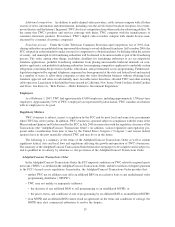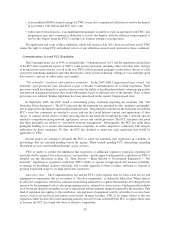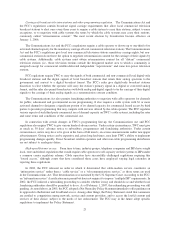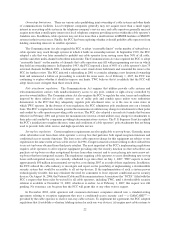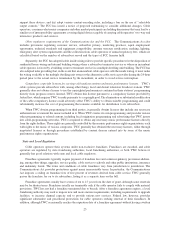Time Warner Cable 2006 Annual Report Download - page 19
Download and view the complete annual report
Please find page 19 of the 2006 Time Warner Cable annual report below. You can navigate through the pages in the report by either clicking on the pages listed below, or by using the keyword search tool below to find specific information within the annual report.through the maximization and careful management of its systems’ existing bandwidth, without costly upgrades. For
example, to accommodate increasing numbers of HDTV channels and other demands for greater capacity in TWC’s
network, in certain areas TWC has begun deployment of a technology known as switched digital video (“SDV”).
SDV ensures that only those channels that are being watched within a given grouping of households are being
transmitted to those households. Since it is generally the case that not all channels are being watched at all times by a
given group of households, this frees up capacity that can then be made available for other uses. This expansion of
network capacity does not rely on extensive upgrade construction. Instead, TWC invests in switching equipment in
its headends and hubs and, as necessary, segments its plant to ensure that switches and lasers are shared among
fewer households. As a result of this process, capacity is made available for new services, including HDTV
channels.
Video, High-speed Data and Voice Distribution
In most systems, TWC delivers its services via laser-fed fiber optic cable from the headend, either directly or
via a hub, to a group of nodes, and uses coaxial cable to deliver these signals and services from individual nodes to
the homes they serve. A typical hub provides service to approximately 20,000 homes, and TWC’s average node
provides service to approximately 500 homes.
National and regional video services are generally delivered to TWC through satellites that are owned or leased
by the relevant programmer. These services’ signals are transmitted to downlink facilities located at TWC’s
headends. Local video signals, including local broadcast signals, are picked up by antennae or are delivered to
TWC’s headends via fiber connection. VOD content is received using a variety of these methods and generally
stored on servers located at each system’s headend.
TWC delivers high-speed data services to its subscribers through its HFC network, its regional fiber networks
that are either owned by TWC or leased from third parties, including, in some instances, AOL LLC (formerly
America Online, Inc., “AOL”), a subsidiary of Time Warner, and through backbone networks that provide
connectivity to the Internet and are operated by third parties, including AOL. TWC pays fees for leased circuits
based on the amount of capacity used and pays for Internet connectivity based either on a fixed fee for a specified
amount of available capacity or on the amount of data traffic received from and sent over the provider’s backbone
network. TWC provides all major high-speed data customer service applications and monitors its IP network,
through its operation of two national data centers, eight regional data centers and two network operations centers,
including one acquired in the Adelphia Acquisition.
TWC delivers Digital Phone voice services to its customers over the same system facilities used to provide
video and high-speed data services. TWC provides Digital Phone customers with a voice-enabled cable modem that
digitizes voice signals and routes them as data packets, using “Internet protocol,” a common standard for the
packaging of data for transmission, over the cable system to one of TWC’s regional data centers. At the regional
data center, a “softswitch” routes the data packets as appropriate based on the call’s destination. Calls destined for
end users outside of TWC’s network are routed through devices called “session border controllers” in the session
initiation protocol format and delivered to TWC’s wholesale service providers. Such calls are then routed to a
traditional public telephone switch, operated by one of TWC’s wholesale service providers, and then to their final
destination (e.g., a residential or business end-user, a 911 dispatcher, or an operator). Calls placed outside of TWC’s
network and intended for TWC’s subscribers follow a reverse route. Calls entirely within TWC’s network are
generally routed by the softswitch to the appropriate end user without the use of a traditional public telephone
switch.
Set-top Boxes
TWC’s Basic and Standard tier subscribers generally do not require a set-top box to view their video services.
However, because TWC’s digital signals and signals for premium programming are secured, TWC’s digital video
customers receiving one-way (i.e., non-interactive) programming, such as premium channels and digital cable
networks, can only receive such channels if they have a digital set-top box or if they have a “digital cable ready”
television or similar device equipped with a CableCARD (discussed below). Customers receiving TWC’s two-way
video services, such as VOD and TWC’s interactive program guide, must have a digital set-top box that TWC
14


